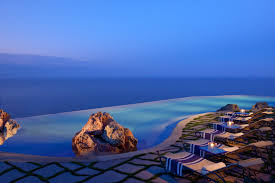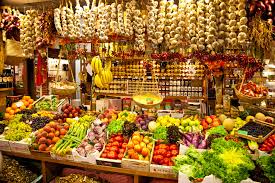– Ed Stoppard
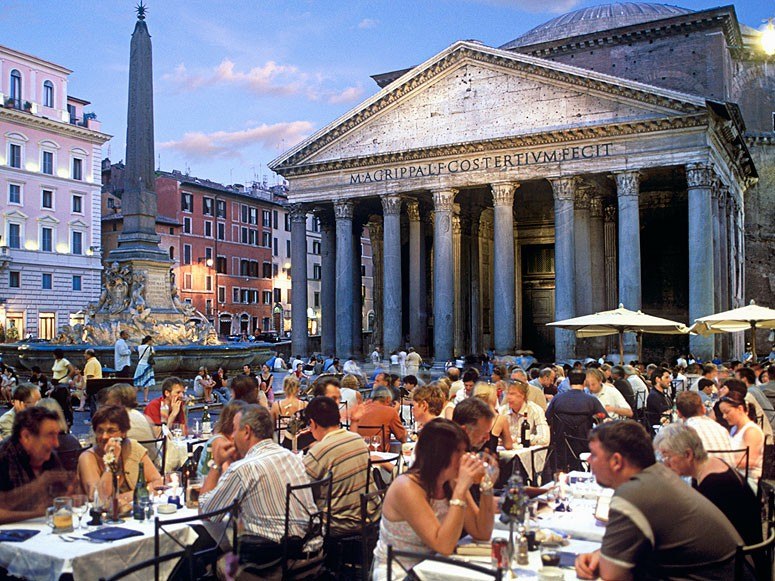
Rome:
For the twenty-fourth year in a row, my wife and I, along with our daughter, are taking our annual “vacation” in the company of two dozen clients from around the country.
This year’s trip should be memorable, but it will not be particularly profitable. The planning has taken far too much of my time. Seeing Italy by cruise ship would have been easier. The logistics have been challenging, primarily because the entire thirteen night journey will be spent in Rome and points south.
In Italy, there are two economies. There are two ways of looking at life. There are latent antagonisms that go back centuries. The north and south don’t get along particularly well. Snobs in Florence and Milan see the southerner as a lout, not sophisticated, not well-dressed, and, shame of all shames, a people enamored by simple pleasures like lemons and tomatoes.
Having lived in northern Italy for six years, I am very much aware of these generalizations about the south. The north feels the south is a drag on its economy. The police who patrol northern cities in Italy have always hailed from the south. Just like the trash collectors.
But unlike the tours, culinary and otherwise, that I’ve put together for our clients, this trip has a rather specific purpose. It is called “In Search of southern Italy’s Best Pizza.” That means we will have to go to Sicily, walk the back streets of Naples, and try the best that they have to offer along the Amalfi Coast. Then back to Rome to make certain that we have not overlooked a crust in some pizza joint with toppings deserving of being named “Italy’s Best Pizza.” At the end of the trip, we will be voting by secret ballot, having experienced some of the best pizza Italy has to offer. I want you to come along with me on this trip.
We start out in the Eternal City, eternally chaotic Rome. We stay for a few nights at a four-star hotel called the Rose Garden Palace, a favorite of our ground operator, Abercrombie & Kent Italy. It is a pleasant place with a lovely garden dining area and good access to a number of area restaurants. It also happens to sit directly across the street from one of the main security gates at the American Embassy.

One member of our group, whose room overlooked the gate of the embassy, told me she had a hard time leaving the hotel in the evening as the show right outside her window was so fascinating. Every person was questioned, every car was searched, even the incoming food was inspected.
Rome seems to me to be more orderly than I remember it, with street construction, a huge undertaking given the potential treasures underfoot, seeming to be everywhere.
I read the local news before arrival and during my stay, something I always do when I travel. Rome got a new Prime Minister this year, 39 year-old Matteo Renzi. I hesitate to use his name as this will seriously date my piece because no one can possibly know if he will still be in office when you read this. But Mr. Renzi is young, rather handsome, elegantly dressed at all times, and he was the former Mayor of Florence. He helped lead the opposition to the notorious Silvio Berlusconi and some in Italy expected a rash of reform. After all, precisely half of his 16-member cabinet is female, a sort of revolution in Italy.
But alas, during my stay in Rome the papers headlined “Renzi accused of appointing female ministers based purely on their looks and youth.”
Change comes slowly to Rome – if at all. And amidst all of the incredible history and movie-set elegance of the city, the major question on the mind of most tourists is “why anyone would ever choose to drive a bus here”?
On Day two we headed for the Rome central market, the new one, where we stopped to taste fruits and vegetables we haven’t seen before. It may have been the environment but we tasted tomatoes that made us angry, angry at the fake food we allow to be sold in the States, including chemically altered tomatoes.
I found a stand that sold small bottles of my favorite Italian vice, tartufo salsa. These tiny jars of truffle paste can turn ordinary dishes at home into something magical and a little bit goes a long way.
After the Testaccio market, we headed to a small villa in the center of Rome, down a lovely side street. We met a delightful Chef named Daniela, who showed us how to cook a complete summer meal which we enjoyed at a long table in the garden.
The next day, I had designed two tour experiences that were a bit off the charts. I wasn’t at all sure how things would turn out but they were both experiences that I wanted our clients to try.
First, we headed over to the Universita’ La Sapienza in central Rome. With 130,000 students, this is the largest educational institution in Europe. And our tour leader was a guide who had been a student there. I had requested an honest appraisal of the Italian educational system and I think we got one. After our tour of the campus, we met in a vacant classroom with one of the school’s dean’s, a woman involved in overseeing a number of academic programs.
The three hours we spent at the University were like a skit out of Saturday Night Live. Everything was a disconnect. Our questions received answers that often bordered on the incredulous. Here were my take-aways:
- Almost everyone attends an educational institution that is publicly funded.
- Many students have great difficulty finding the building on campus and the room where their classes are being taught. No one has a guidance counselor. Since education is essentially free, the attitude of the administration seems to be “you’re in college so it’s your job to figure out how to sign up for coursea and how to find your professor.” This is made more challenging since professors often change their rooms and are quite arbitrary about what time they will be teaching. We met two students who said that at least one of their professors had re-scheduled a class in the middle of the night due to dinner engagements.
- Students may “reject” their grade. They have the right to take a course as many times as they wish until they achieve the grade they deem acceptable.
- Since the education is essentially free, and unemployment among the young is approaching 30%, students take their time. Many do not complete their college education until they are well into their thirties.
- There is no social stigma attached to living at home with one’s parents, something many young people do well into their forties to save on rent, dry cleaning, and the cost of dining out.
The following day, things started getting serious. We were deposited at the doorstep of Tony Vespa at his well-known pizzeria Al Grottino. Mr. Vespa is a Canadian with a sharp wit and a passion for making pizza the classic, “technically correct” way. He married a Roman woman and lived in the city perfecting his pizza techniques for thirty years.
Our hands-on class lasted four hours and culminated in the design, from scratch, of a certified “world class pizza” cooked by each of us. Some were better than others, as we each used different ingredients. But the crust had to be perfect or we would be instructed to start again. We had to place the pizza in the brick-oven and heat it just right.
I have more to tell you about pizza than space to tell it. So just let me close with two bits of insider pizza education.
01 – If your pizza is not charred a bit on the bottom of the crust, it is not cooked properly.
02 – The rudest thing a pizza maker can do is slice a pizza before serving it to guests. Slicing up a perfect pizza is a truly personal decision.
Next, we leave for Naples where we found Italy’s best pizza in a rather unlikely place.
SICILIAN SURPISES
“Unni mancianu dvi. mancianu tri”
“Sicilian proverb meaning “There’s always room for one more.”
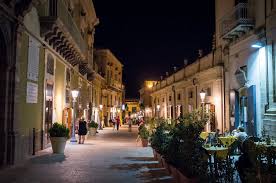
After beginning our culinary march through southern Italy in Rome, we landed in Catania, the tip of the Italian boot, with views of Mt. Etna in the background the Mediterranean and the Ionian Sea forming suitable backdrops to a seemingly endless collection of historic leftovers from the conquering Greeks and Romans.
Our first stop was to be the most odiferous in Sicily, the colorful, grimy, and superbly smelly main Fish market.
Two people in our group regrettably wore sandals, carefully stepping over fish debris that has missed the big white buckets next to every fish monger.
We arrived shortly before closing and the prices were starting to come down. Shouts of “Ho I prezzi migliori” (My prices are the best) could be heard as we passed the open tables and stalls. Upstairs there is a more refined market selling meats, cheeses, and all the mnost beautiful vegetables I’ve seen at any market with the possible exception of Les Halles in Avignon.
Our walk-through was more exciting than anticipated as the last series of fishmongers, set up just outside the main hall, felt it necessary to comment on the positive attributes of every woman who passed before them. One would think they would be paying more attention to the sharp knives and cleavers in their hands. But I forgave them because, the fact is that the Catania market is unique in that shopping is done mostly by men, whose job it is to buy the daily fish. Many stop briefly for a quick game of cards (I don’t suppose they are playing “fish”) before heading home with the evening’s dinner. The men of Sicily pride themselves on being able to choose the best of the catch from fifty feet.
We had lunch near the pier in a restaurant that overlooked the harbor and we then set out for a ride along the coast. We were heading to Ragusa which is not far off the coast of Africa and surprisingly close to the Equator.
I try to take in the scenery and to try to identify its uniqueness. This part of Sicily is the epicenter of an area that is being touted as Italy’s best food belt, with leading food writers and chefs including Mario Batali anointing it as the home of the country’s most honest raw materials.
The landscape does not prepare you for the culinary surprises ahead. Eastern Sicily has small hills and a rock-strewn landscape with carob forests and ancient stone walls cropping up in the middle of seemingly barren earth.
The land is broken up into small divisions set off by low pile ancient stones to denote a piece of land belonging to an individual or a family of individuals. It seems primitive unless you ponder how long this system has been in place and how long it has worked well. And then there are the sudden, unanticipated swaths of green, olive groves here, fields of lemon trees there.
Is it my imagination or does this place smell better than any destination I’ve ever visited?
We are staying at the luxury residence, Eremo della Giubilna. Walking up the long driveway we pass gardens and get a view of the hotel’s small airport. We will be staying at an old Arab feudal home, a fortified fortress overlooking the sea. It was, like so many of Italy’s best properties, formerly a convent. Built in the 12th century, the property has corners and courtyards that hint at its history. I will be sleeping in one of the former cells of a friar who once called the place home. I imagine the flat-screen TV is new.
The food was spectacular as was the wine cellar. In the 18th century the Nifosi family of wealthy landowners bought it and later restored it to what it has become. My favorite memory of the place occurred the night I walked out of the dining room and found a small, 91 year-old “Nanna” seated in a high chair. She looked a bit out of place and her body remained still while her eyes took in the movement of guests all around her. I think that many guests in our group did not imagine she that is the Nifosi who still owns the property.
After checking in and relaxing for a while we set out to drive to Ragusa to have dinner preceded by the wonderful Italian tradition of “passeggiata”, which should translate to “walking about town speaking with one’s neighbors, perhaps a few strangers, while stopping for an aperitif and some light snacks just before choosing a place to seriously dine”.
I have to say that I was shocked by the beauty of this town, with its perfect streetlights, hilly main street, friendly locals, lack of tourists, and sense of serenity. It didn’t hurt that the smells coming off the outdoor tables at the many small restaurants is something I will never forget.
As I walked through this movie set, it occurred to me that Sicily does not have an organic food store. The largest island in the Mediterranean is entirely organic. All of the food is grown locally and chemicals are unknown. Residents would never use the term, but the entire place in “Farm to Table”. I picked up a tomato at a small food stall and was invited to taste it by the owner. Sorry Whole Foods. You still have a way to go.
Our passeggiata was cut short by an appointment we had at the historic home of the local Baron. We knocked on an old wooden door on the main walking street and were ushered into a lovely downstairs courtyard where the Baron met us warmly and introduced us to his guests, the leading anti-mafia police Commander and the prosecuting attorney who would help keep the conversation “on track” without revealing the status of current “investigations and projects.” This was something I had wanted to set up but I didn’t know until we arrived that they would agree to the invitation. The Commander looked regal in his dress Carabienari unform. He was accompanied by a tough-looking investigator in a rumpled sports jacket, a fellow I would not want on my tail.
After pleasantries, the Baron invited us upstairs into his home. We had a heartfelt tour of the house, viewing pictures of his family and pausing before the family chapel. The Baron was beaming, having just learned he was to become a grandfather. We walked into the grand ballroom and toasted the news. Windows overlooked the town square and straight out the window, in the distance, we saw a beautiful church lit up to reflect a golden hue as the sun set over the hills behind the village.
The Baron and the attorney had wanted us to taste some of the lovely local specialties so we enjoyed drinks and conversation. I was about to start the Q and A with the local police when I noticed that the investigator had left, leaving the Commandant to brave the questions of the American visitors by himself.
Some of what was said should remain private and few real secrets were revealed. But we came to understand that the Sicily of the “Godfather” movies is somewhat removed from current realities. In fact, the three branches of organized crime in Sicily, of which the mafia is the least significant, have found better opportunities in the larger cities.
It was a warm, friendly evening and our hosts seemed genuinely touched that we were interested in their town and their way of life.
We left, walking out into the still warm evening light, to pick our spot for dinner. It was getting late, but as we wandered the hilly streets, hearing the conversation and the laughter as we passed each place where food was being enjoyed, we felt lucky to be here. And concerns about our safety was never an issue. The good Commandant would see to that.
FROM CHAOTIC NAPLES TO THE CALM OF THE AMALFI COAST
“Put a compass to paper and trace a circle. Then tell me which other country has such a concentration of places like Amalfi, Naples, Ischia, Procida, Sorrento, Positano, Pompeii, and Capri”
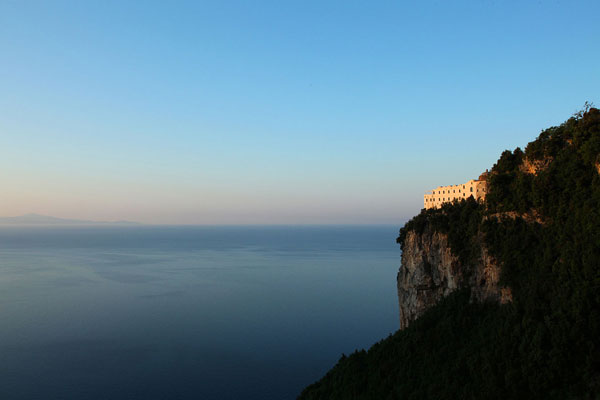
When your local guide bursts into laughter as he begins to attempt to describe his city, you know you are in for an experience, of sorts.
“In Naples, you know,” the guide begins, “they say all of the crazy people in Italy, the really crazy ones who are not politicians, live in Naples. But I know there are some people here who are not so crazy. We are just waiting for them to identify themselves.”
And so begins the story of Napoli as our vehicle moves forward. As the guide goes on about the chaos that is his city, there are many examples. No one believes a street sign really should be taken “literally”, and being aggressive is not necessarily rude. As he is peaking, a cast of locals, as if they were witnesses for the prosecution, cut us off on their motorbikes and cross the streets in the middle of traffic with an abandon that closely approaches a kind of death wish as urban ballet.
I love this place and no local guide is going to talk me out of my appreciation for the cobblestone streets that make walking a game of chance, the narrow alleys adorned with thousands of colorful bits of laundry on lines stretching from building to building, the old men playing cards in doorways and parks, and the frantic children running, never walking, past their momma’ sitting on chairs outside their front door. It is the only city I know where people routinely talk with strangers from their mopeds while sitting in traffic. A fun game is to count the Neopolitan “shrugs”. This is the ultimate “such is life” city.
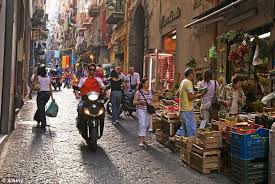
Naples has corruption that is almost enjoyable to watch. Locals find it amusing and discuss it over their morning espresso or their warm afternoon “shakerato”, an iced espresso served in a properly chilled glass. The city brags about the quality of its art and the skill of its pickpockets.
Then there is the pizza. Much of it is larger than the plate it rests on. Proper Neapolitan pizza has few ingredients. Anyone caught serving a “Hawaiian” pizza would be quickly invited to move north. It is the essentials that matter. Although our search for Italy’s best pizza involved stops in Rome and along the Amalfi Coast, it was in a small, rather well worn, small pizzeria named Il Pepperoncino Birchino that we found the holy grail.
This small place is tucked in the middle of Santa Lucia, a street with several upscale pizzas, one or two of some reputation.
Look at the guide books and you will not find Il Pepperoncino mentioned. Da Michele, with its long lines and only two options, Margherita or Marinara, gets the press. Trianon da Ciro is a local favorite, proven by its 82 year history baking Neopolitan pies.
Our judges chose Il Pepperoncino because, I suppose, it was both delicious and very different than any other tasting we had experienced.
The sweet dough made with the just so Ph level, and that “sacred” Naples water, is stuffed with the freshest ingrediants and then, ever so lightly, fried. When served the insides are encased is a piping hot hat, and there is a slight whoosh as you cut into the first piece. One of our judges referred to it as “the world’s best Neopolitan chicken pot pie – without the chicken, of course.”
Anyway, at the end of our trip, after the ballots were counted, flat pizzas lost out to a version we had never seen anywhere. It was unexpected and I hope you get to try one some day soon.
We left Naples for the Amalfi coast where we would be staying at a new, small hotel, just outside of Amalfi. We would then be heading to Positano for a few nights at Le Siranuse, regarded by all of the major travel magazines as the very top property south of Rome.
Le Siranuse did not disappoint. But the hotel that preceded it just about floored us.
In 1999, after the passing of her husband, a hotelier you have never heard of, Bianca Sharma, was with several longtime friends and her teenage sons, on a boat trip along the Amalfi coast. She looked up and somehow noticed the remains of a former monastery perched on the very tip of a near vertical cliff. The building was falling apart, but she asked the boat captain who owned it and he said he thought it was for sale.
Ads with anything involving renovation of historic properties in Italy, the process was quite daunting. But the former sequestered convent became a labor of love for Ms. Sharma and she lovingly restored it for more than ten years. No detail was overlooked and the redesign and rebuilding process has resulted in the opening of a twenty-room luxury property that is, in my view, Europe’s best new small hotel and certainly the new reigning queen of top properties along the Amalfi Coast.
I was traveling with my family and two dozen clients. It was the general consensus of our well-traveled group that Monestero Santa Rosa is the finest property we have ever experienced anywhere in the world. That it was designed and is overseen by a woman with no real hotel industry experience is an industry miracle.
This was all a bit of a surprise. We had heard that the first guests at the property was Prince Albert and Princess Charlene when it opened in 2012. It is, like several other small properties in Italy including the Townhouse at the Galleria in Milan, not particularly well known outside of A-listers and travel consultants who deal with those seeking unobtrusive excellence without attracting undue attention.
I lack the talent to put our stay into words. What made it so special? Was it the way staff rings an ancient bell in the small courtyard whenever new guests arrive or depart? The idea that staff would drop what they are doing to bid hello or farewell to guests says a great deal about this place.
Is it the terraced views, simply incomparable? Is it the caring concern of the Manager, Flavio Colantuoni, that all is perfect? Is it the carefully tendered orchard and vegetable garden just across the road? This is where Chef Bob sources his incredible dishes.
As we arrived, the bells started tolling. We were met by staff and ushered onto a side terrace with perfect views of the coast. The excellent bar manager made certain that we were all part of his inner circle, and he is a master.
For many, it is the perfection of the furnishings, the antiques, and so many surprises. Quick, come with me and look on the lower floor near the library. See the four tiny rooms with floor drains?
This was where the nuns who had died were placed so their bodily fluids could run out before they were embalmed.
I slept in one of the nuns cells. Each room is named for a medicinal local herb like, Sage, Lavendar, and Salvia. I am not sure that the nuns would recognize the chic furnishings but they would recognize the confessional in the hallway.
Perhaps, what is most symbolic of the Monastero’s ability to create lasting memories is the walk down, past lovely gardens, many of them hidden so that each step outside brings new discoveries, to the swimming pool. It is a huge, slightly sloping infinity pool and you can swim up to the edge and see the steep drop white cliffs below.
On my last day, two sea gulls came up silently behind me in the pool to linger, have a drink, and, I believe, to say goodbye.
As the bells were rung on departure there were more than a few tearful goodbyes. If you’ve been with me for a while in this space, you know it is not my habit to gush over hotels. Forgive me. I had to share this one with you.
It was a huge transition from the chaos of Naples to the beauty and tranquility of Monastero Santa Rosa. But, perhaps it is fitting that Naples be followed by some time in a nun’s cell with confession box nearby.
